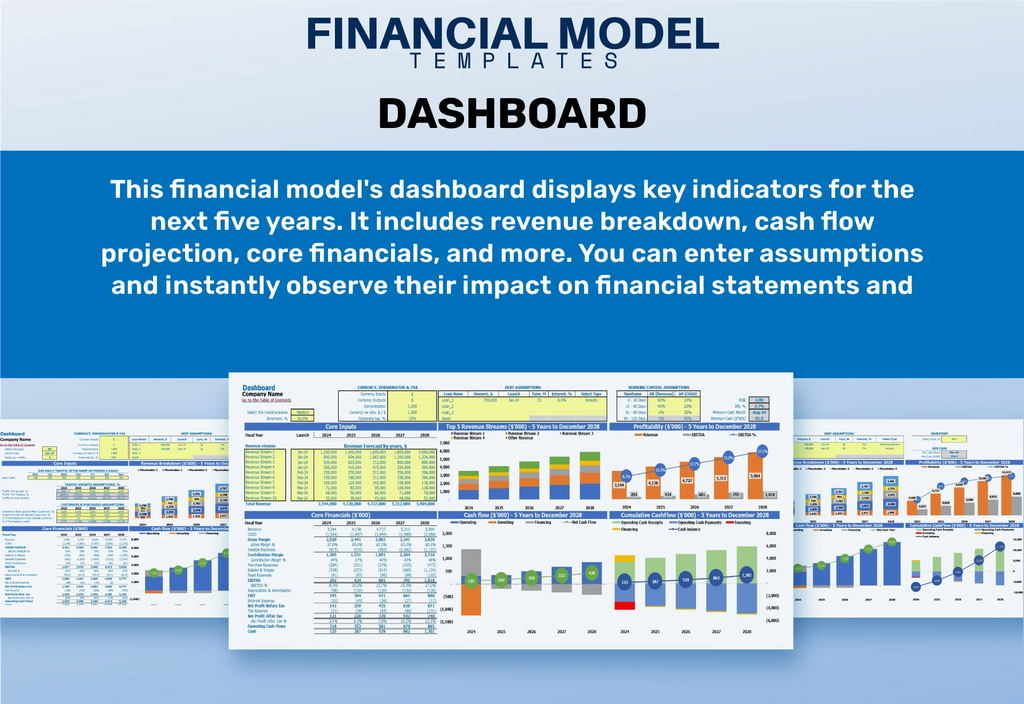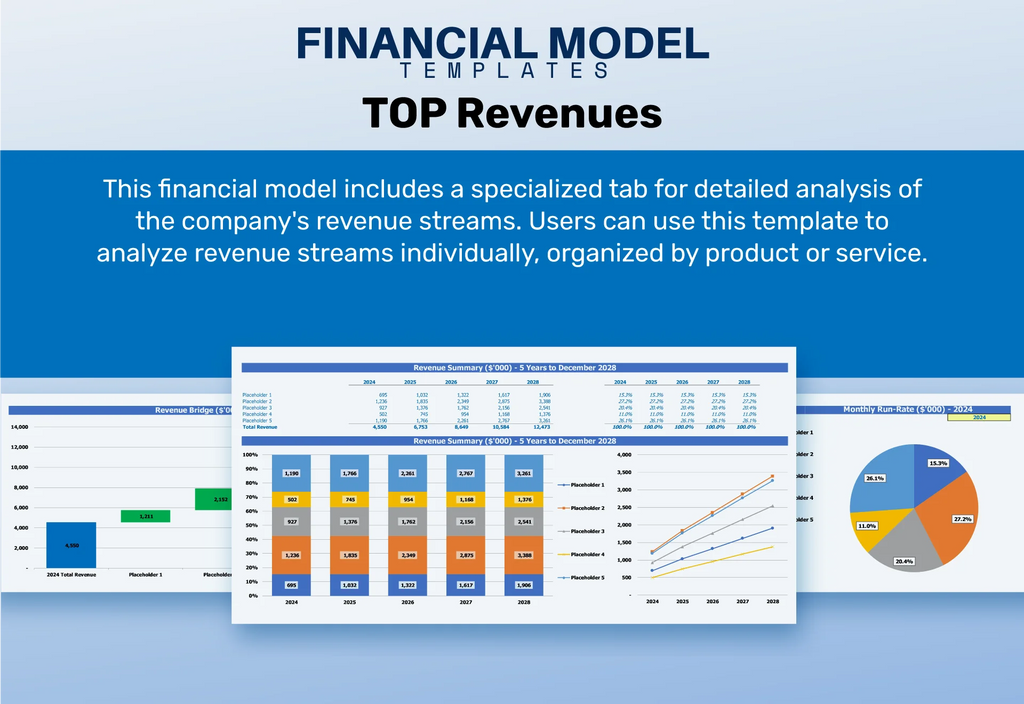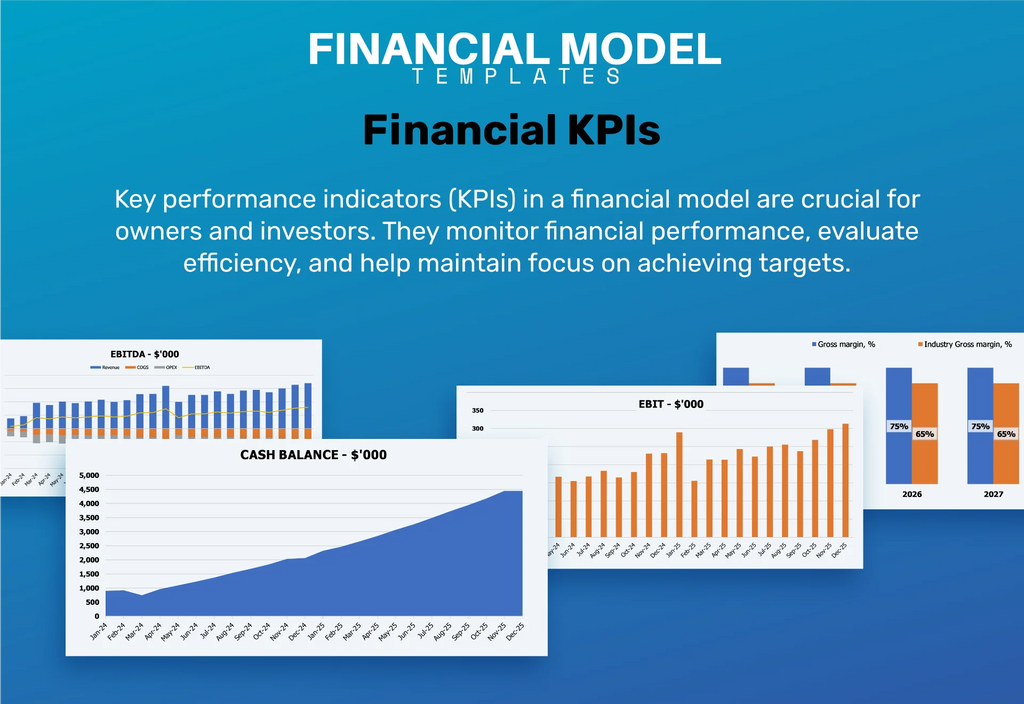Distribution Center Financial Model

- ✔ 5-Year Financial Projections
- ✔ 100% Editable
- ✔ Investor-Approved Valuation Models
- ✔ MAC/PC Compatible, Fully Unlocked
- ✔ No Accounting Or Financial Knowledge
Distribution Center Financial Model
Bundle Includes:
ALL IN ONE MEGA PACK - CONSIST OF:
distribution center Financial Model/Business Plan Excel Template
Pitch Deck Template For PowerPoint, Keynote & Google Slides
Business Plan Guide and Business Plan Template in MS Word Format
Financial Dashboard in Excel To Track Your Business Performance
DISTRIBUTION CENTER FINANCIAL MODEL FOR STARTUP INFO
Highlights
This five-year distribution center financial forecast template in Excel is specifically designed for startups and entrepreneurs looking to impress investors and secure funding. It incorporates essential elements such as logistics financial projections, operational expense forecasting, and revenue stream analysis, enabling users to create a comprehensive warehouse profitability model. The template features built-in charts and summaries for cost-per-order calculations and break-even analysis for warehouses, while also addressing overhead cost allocation and working capital requirements. With a focus on supply chain financial metrics, including inventory management costs and transportation budget forecasting, this tool aims to enhance logistics operational efficiency and support capital expenditure planning, ensuring that users can effectively communicate their financial KPIs for distribution centers to potential investors.
The distribution center cost analysis within this Excel template addresses key pain points by providing a structured framework for logistics financial projections, focusing on operational expense forecasting and inventory management costs to enhance warehouse profitability. By incorporating a comprehensive overhead cost allocation and fixed and variable costs analysis, users can effectively optimize their distribution network while evaluating transportation budget forecasting and working capital requirements. The model aids in revenue stream analysis and break-even analysis for warehouses, enabling businesses to assess their financial KPIs and profit margins more accurately. Additionally, with features such as the economic order quantity model and cost-per-order calculations, users can streamline supply chain cash flow management and improve logistics operational efficiency, ensuring a robust financial strategy that adapts to their evolving needs.
Description
The distribution center financial model is designed to facilitate comprehensive distribution center cost analysis, allowing for effective logistics financial projections that enhance warehouse profitability through strategic operational expense forecasting. By incorporating supply chain financial metrics and analyzing fixed and variable costs, the template aids in optimizing the distribution network while managing inventory management costs and capital expenditure planning. Furthermore, it supports transportation budget forecasting and working capital requirements, enabling revenue stream analysis and cost-per-order calculations for precise break-even analysis for warehouses. This holistic approach ensures effective supply chain cash flow management, while overhead cost allocation and financial KPIs for distribution comprehensively assess profit margins and logistics operational efficiency.
DISTRIBUTION CENTER FINANCIAL MODEL REPORTS
All in One Place
In business, effective management is crucial. Our comprehensive distribution center cost analysis serves as a strategic roadmap for optimizing logistics financial projections. For start-ups, this Excel template enhances inventory management costs and operational expense forecasting, ensuring robust supply chain cash flow management. By leveraging key financial KPIs for distribution, you can assess fixed and variable costs, streamline your transportation budget, and understand working capital requirements. This model facilitates revenue stream analysis and break-even analysis for warehouses, empowering you to navigate liquidity challenges and extend your cash reserves with confidence.

Dashboard
Our financial projection template Excel features a dynamic dashboard that consolidates essential indicators for optimizing your logistics operations. This powerful tool simplifies the process of cost analysis, allowing you to assess warehouse profitability, operational expenses, and inventory management costs. With capabilities for revenue stream analysis and transportation budget forecasting, you can effectively project cash flow and evaluate financial KPIs for distribution. Harness this dashboard to enhance your capital expenditure planning and improve overall operational efficiency, ultimately leading you toward achieving your financial goals.

Business Financial Statements
Each financial statement plays a crucial role in understanding a company's financial health. The projected income statement reveals profit generation from core operations, while the projected balance sheet provides a snapshot of capital structure and financial position over the next five years. Complementing these, the cash flow forecast outlines the financial dynamics of operating, investing, and financing activities. Together, they facilitate a comprehensive cost analysis for logistics and supply chain management, enabling informed decisions on inventory management costs, operational expense forecasting, and optimizing revenue streams for enhanced warehouse profitability and logistics operational efficiency.

Sources And Uses Statement
The sources and uses of funds are crucial for a comprehensive financial plan. This element outlines the flow of funding, detailing both revenue streams and cash distributions. By integrating logistics financial projections and capital expenditure planning, organizations can achieve optimal warehouse profitability. Understanding working capital requirements and overhead cost allocation allows for effective operational expense forecasting. Additionally, leveraging financial KPIs and cost-per-order calculations enhances supply chain cash flow management and assists in distribution network optimization, ensuring a sustainable and efficient logistics framework.

Break Even Point In Sales Dollars
The break-even point is crucial for assessing the sales volume required to cover total fixed and variable costs in a distribution center. At this threshold, profits are zero, but surpassing it leads to revenue generation. Utilizing our financial modeling Excel template, you can create a customized break-even chart to visualize necessary sales levels for profitability. This tool aids in evaluating supply chain financial metrics, enhancing logistics operational efficiency, and supporting capital expenditure planning. For investors, understanding the break-even analysis is vital for gauging profitability potential and estimating recovery timelines for their investments.

Top Revenue
Effective revenue generation is crucial for sustainable business success. When developing a profit and loss projection, management must accurately forecast future revenues, as this is a key driver of enterprise value in pro forma financial statements. Inaccurate forecasts can undermine the entire financial model. Financial analysts should utilize profit margin assessment, operational expense forecasting, and supply chain financial metrics to create precise projections. By leveraging historical data and employing models like the economic order quantity, teams can enhance revenue stream analysis, ultimately improving logistics operational efficiency and ensuring robust working capital management.

Business Top Expenses Spreadsheet
Management's top priority is generating sustainable revenue. To achieve this, accurate logistics financial projections are vital, as they significantly influence the overall business plan financial model. An imprecise revenue forecast can disrupt all financial metrics, including operational expense forecasting and capital expenditure planning. Therefore, it’s essential for management and analysts to meticulously craft a warehouse profitability model, ensuring a comprehensive understanding of working capital requirements and cost-per-order calculations. Utilizing detailed assumptions based on historical data will enhance the economic order quantity model, enabling effective distribution network optimization and ultimately improving the enterprise's profitability and operational efficiency.

DISTRIBUTION CENTER FINANCIAL PROJECTION EXPENSES
Costs
This financial forecasting model equips you with robust logistics financial projections for up to five years, facilitating effective budgeting and operational expense forecasting. By monitoring cost variations, you can optimize your distribution center cost analysis. Key parameters such as income percentages and inventory management costs are seamlessly integrated, enabling precise cost-per-order calculations. The template distinguishes between fixed and variable costs, encompassing COGS, wages, and capital expenditure planning. With this sophisticated tool, enhance your supply chain financial metrics and ensure effective supply chain cash flow management for sustained warehouse profitability.

CAPEX Spending
A well-planned capital expenditure reflects a company's investment in long-term assets that generate value beyond one year, such as computers, which appear on the projected balance sheet. In contrast, ongoing expenses like electricity are included in operational expense forecasting. Each asset's useful life allows for depreciation, impacting the proforma income statement and reducing its balance sheet value. This strategic overview, including fixed and variable costs analysis, helps stakeholders understand overall expenditures and supports logistics financial projections, enhancing distribution network optimization and profitability assessments.

Loan Financing Calculator
Our business plan Excel financial template features a comprehensive loan amortization schedule, providing detailed insights into both principal and interest calculations. This template streamlines financial projections by calculating your company’s payment amount, taking into account the principal, interest rate, loan duration, and payment frequency. Incorporating this tool enhances your cash flow management and supports strategic capital expenditure planning. By utilizing this effective resource, you can optimize your logistics operational efficiency and improve overall financial KPIs for your distribution center, facilitating a proactive approach to cost analysis and inventory management.

DISTRIBUTION CENTER EXCEL FINANCIAL MODEL METRICS
Financial KPIs
Return on equity (ROE) is a vital financial metric for evaluating a startup's profitability and efficiency. By leveraging data from pro forma balance sheets and profit-and-loss statements, ROE is derived by dividing net income by average shareholders' equity. This analysis not only sheds light on a company's financial health but also supports distribution center cost analysis and logistics financial projections. Understanding this metric aids in enhancing warehouse profitability, optimizing fixed and variable costs, and improving overall supply chain cash flow management, ultimately driving better investment decisions and operational efficiency.

Cash Flow Forecast Excel
A robust cash flow forecast is essential for demonstrating your business's capacity to generate sufficient funds to cover liabilities and operational expenses. This analysis is vital not only for internal operational expense forecasting but also for financial institutions, as they rely on these projections to assess your capacity to service bank loans. By incorporating logistics financial projections and key supply chain financial metrics, you can enhance your distribution center cost analysis, optimize your distribution network, and ultimately strengthen your financial KPIs for distribution, ensuring sustainable profitability and growth.

KPI Benchmarks
A benchmarking study serves as a vital component of a five-year financial projection template, enabling businesses to evaluate performance using key financial metrics like profit margins, cost per order, and productivity ratios. By comparing these indicators with those of industry peers, companies can identify areas for improvement and optimize their operational efficiency. This strategic management tool is particularly beneficial for startups, allowing them to align their logistics financial projections and supply chain cash flow management with industry best practices. Leveraging such insights enhances decision-making and supports effective capital expenditure planning to drive warehouse profitability.

P&L Statement Excel
Investors prioritize the projected profit and loss statement for assessing a company's profitability potential. However, this statement alone doesn't capture the complete financial picture. It omits critical elements like total assets and liabilities essential for profit generation. Our comprehensive financial forecasting model encompasses vital components such as distribution center cost analysis, operational expense forecasting, and logistics financial projections. By integrating supply chain financial metrics and profitability models, you gain a holistic view of your business, enabling you to optimize costs, enhance operational efficiency, and accurately assess profit margins and working capital requirements for sustainable growth.

Pro Forma Balance Sheet Template Excel
The pro forma balance sheet template provides a snapshot of a corporation's assets and liabilities, crucial for assessing its financial health. Coupled with a forecasted profit and loss statement, it reveals operational results and financial positioning over time, highlighting key supply chain financial metrics. Analyzing liquidity, solvency, and turnover ratios is essential for effective operational expense forecasting and revenue stream analysis. This comprehensive approach supports informed capital expenditure planning and aids in optimizing warehouse profitability by evaluating fixed and variable costs, ultimately enhancing logistics operational efficiency and financial KPIs for distribution.

DISTRIBUTION CENTER FINANCIAL PROJECTION TEMPLATE VALUATION
Startup Valuation Model
Investors can access vital insights through our comprehensive distribution center financial model template tailored for startups. Key metrics include the weighted average cost of capital (WACC), highlighting the minimum return rate on investments. Our analysis covers Free Cash Flow (FCF), revealing available cash for all stakeholders post-operations and investment, and utilizes Discounted Cash Flow (DCF) to present future cash flows at their present value. By emphasizing logistics financial projections, overhead cost allocation, and warehouse profitability models, this template ensures informed decision-making and optimized supply chain financial metrics for sustained growth.

Cap Table
A cap table is an essential tool for any startup, outlining all company shares, ownership stakes, and investor pricing. This vital document supports logistics financial projections, showcasing each investor’s ownership percentage and potential dilution. By integrating effective cost-per-order calculations and break-even analysis, startups can enhance warehouse profitability models and optimize their distribution network. Keeping track of working capital requirements and operational expense forecasting ensures informed decision-making. Ultimately, a well-structured cap table aids in maximizing financial KPIs for distribution, promoting logistics operational efficiency and sustainable growth.

KEY FEATURES
Achieve enhanced warehouse profitability and operational efficiency with our robust financial model for comprehensive cost analysis and forecasting.
Our advanced distribution center financial projection model empowers you to optimize costs and enhance logistics operational efficiency for maximum profitability.
Implementing a warehouse profitability model enhances logistics financial projections, driving operational efficiency and maximizing profit margins.
Utilizing a robust financial model enhances logistics operational efficiency, allowing for precise adjustments in distribution center cost analysis and forecasting.
Implementing a robust warehouse profitability model enhances logistics operational efficiency, saving both time and money through optimized financial metrics.
The distribution center financial model simplifies planning, enabling you to focus on strategic growth without technical distractions or costly consultants.
Implementing a robust financial model enhances operational efficiency, enabling stakeholders to trust our strategic logistics decisions and optimize profitability.
A detailed cash flow forecast enhances stakeholder confidence, making it easier to secure investment for optimizing warehouse profitability and logistics efficiency.
A robust warehouse profitability model enhances financial projections, ensuring stakeholders receive accurate forecasts for informed decision-making.
A strong distribution center cost analysis enhances financial projections, ensuring banks receive accurate cash flow forecasts for loan assessments.
ADVANTAGES
A robust financial model enhances logistics operational efficiency by accurately forecasting costs and identifying cash gaps before they arise.
Maximize profitability and streamline operations with our 5-year cash flow projection template for effective logistics financial planning.
Enhance decision-making through effective distribution center cost analysis, optimizing logistics financial projections and improving overall operational efficiency.
A robust financial model empowers businesses to anticipate challenges, enhancing logistics operational efficiency and optimizing warehouse profitability.
Optimize your cash flow with financial modeling, enhancing logistics operational efficiency and improving warehouse profitability through precise cost analysis.




